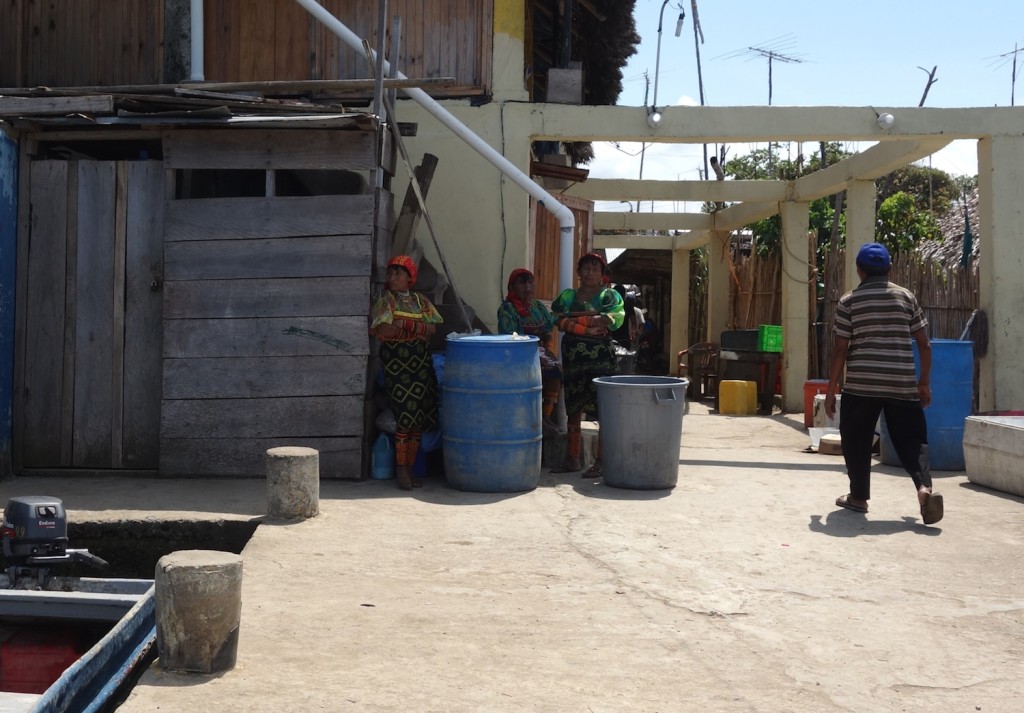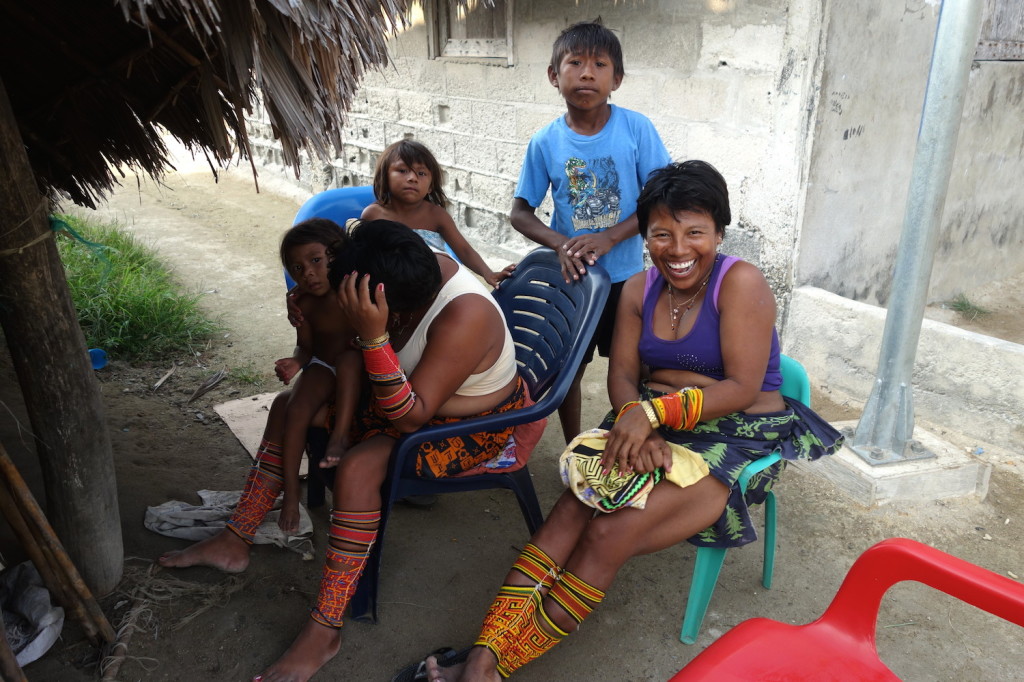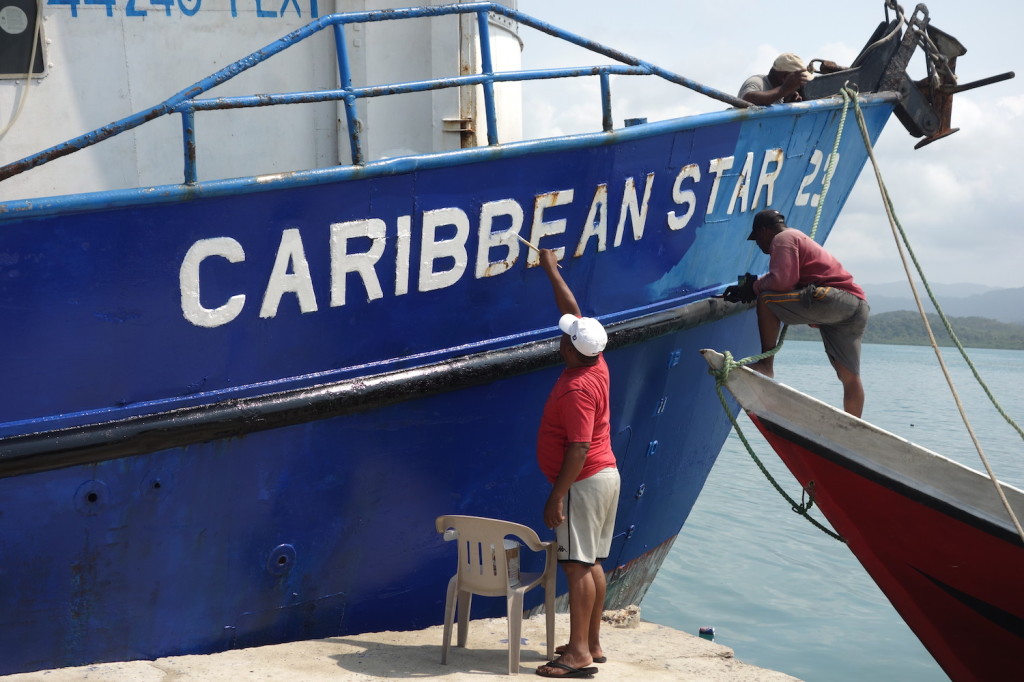In March 2014, I took my small motorbike from Panama to Colombia. Avoiding the jungle I had to transport it through the sea. The first part of the story says a little about the road through the Darien Gap and the reasons why it doesn’t exist.
No surprises here, as usual I had plenty of luck and going through Darien Gap took me only a week. I didn’t get stuck on any island and I saw little bit of fascinating, hidden world. None of my electronics didn’t get wet, motorbike didn’t fall into the water, only the passport got a shower and my US visa looks little bit funny right now. That might make the return trip complicated, but let’s not worry about that too much right now.
To make to the final Columbian stop I had to take three different speedboats (one dry and two wet) and a cargo ship, which was my home for almost six days. The route I covered is as follows (sea sections are marked bold).
Panama City -> Coast of Panama -> Carti Island (Panama) -> Puerto Obaldia (coast of Panama) -> Capurgana (coast of Colombia) -> San Juan De Urabá, close to Arboletes (coast of Colombia) -> Cartagena (Colombia)
 Somewhere on the coast of Panama, just a minute before loading the bike on the speadboat to Carti island. Sea trail over the Darien Gap leads through San Blas islands, autonomous region of Panama, occupied by indigenous Kuna people. Carti island is one of them. The say: today Coca Cola and McDonalds are everywhere. So I went to San Blas and right now I can say that mobile phones reached the end of the world as well.
Somewhere on the coast of Panama, just a minute before loading the bike on the speadboat to Carti island. Sea trail over the Darien Gap leads through San Blas islands, autonomous region of Panama, occupied by indigenous Kuna people. Carti island is one of them. The say: today Coca Cola and McDonalds are everywhere. So I went to San Blas and right now I can say that mobile phones reached the end of the world as well.
 Carribean Star, the ship that took me and my motorbike from Carti to Puerto Obaldia. Few hours before I saw it I met a cook that was going to work there. Looking for easy money he tried to negotiate the price with me, starting from $300 but in the end said that it is not going to be possible for less than $200. Finally I spoke with the captain and agreed on $150. But still I think I overpaid.
Carribean Star, the ship that took me and my motorbike from Carti to Puerto Obaldia. Few hours before I saw it I met a cook that was going to work there. Looking for easy money he tried to negotiate the price with me, starting from $300 but in the end said that it is not going to be possible for less than $200. Finally I spoke with the captain and agreed on $150. But still I think I overpaid.
 The food was better than on Iris from Rio Mammore.
The food was better than on Iris from Rio Mammore.
 One of many islands we visited.
One of many islands we visited.
 One of many paradise islands we didn’t visit.
One of many paradise islands we didn’t visit.
 Indigenous people of San Blas islands, Kuna, speak Spanish and their own language called Dulegaya. They don’t look like Latinos at all and live on packed little islands, that are meter or two above the sea level. In forty years, when big ice mountains from the far north and south will melt and the sea level will raise enough to cover the last island, Kuna will move to the cities, taking of their traditional clothes, forgetting their own language and eventually mixing with Latinos. So go there now to see them… or maybe it’s better to leave them alone?
Indigenous people of San Blas islands, Kuna, speak Spanish and their own language called Dulegaya. They don’t look like Latinos at all and live on packed little islands, that are meter or two above the sea level. In forty years, when big ice mountains from the far north and south will melt and the sea level will raise enough to cover the last island, Kuna will move to the cities, taking of their traditional clothes, forgetting their own language and eventually mixing with Latinos. So go there now to see them… or maybe it’s better to leave them alone?

 The day before we arrived to Puerto Obaldia, our captain instead of taking off ordered to paint the ship. Looking at crew’s work speed I could only guess that they are really bored with being on the sea and everybody just waits to have some fun in Puerto Obaldia. I wouldn’t be surprised if that was just the secret plan of the captain, to motivate seamen to finish their job fast.
The day before we arrived to Puerto Obaldia, our captain instead of taking off ordered to paint the ship. Looking at crew’s work speed I could only guess that they are really bored with being on the sea and everybody just waits to have some fun in Puerto Obaldia. I wouldn’t be surprised if that was just the secret plan of the captain, to motivate seamen to finish their job fast.
The last day we went to Puerto Obaldia, where I hired a speedboat to Capurgana (Colombia).
 Eventually, the final port. Or should I say, some random village by the sea. The original plan was to get to Turbo on a cargo ship. But I accidentally found a speedboat going somewhere between Turbo and Cartagena, for one third of original price to Turbo. I ended up travelling on a boat jumping on the waves for three and a half hours, the trip I’ll never forget (it’s enough time to think about… everything). Finally I landed on some forgotten beach, so tired that I could easily imagine myself landing on the beach in Normandia. I could only suspect that my appearance gave everybody there a reason to talk for a week. If it’s not enough, I realised that you cannot just land somewhere in the middle of nowhere in Colombia. Duty office in Monteria (the closest big city) sent me 300 kilometres further to Cartagena, the only reasonable place I could register my motorbike. And during that trip I couldn’t be stopped by a police, which thankfully didn’t bother me, mainly because with my motorbike I look like a local. Besides, I suppose they are mainly looking for cocaine trucks… Ah, adventure.W Marcu 2014, omijając Darien Gap, przeciągnąłem drogą morską mały motocykl. Część pierwsza historii traktuje o drodze przez Darien Gap i dlaczego właściwie jej nie ma.
Eventually, the final port. Or should I say, some random village by the sea. The original plan was to get to Turbo on a cargo ship. But I accidentally found a speedboat going somewhere between Turbo and Cartagena, for one third of original price to Turbo. I ended up travelling on a boat jumping on the waves for three and a half hours, the trip I’ll never forget (it’s enough time to think about… everything). Finally I landed on some forgotten beach, so tired that I could easily imagine myself landing on the beach in Normandia. I could only suspect that my appearance gave everybody there a reason to talk for a week. If it’s not enough, I realised that you cannot just land somewhere in the middle of nowhere in Colombia. Duty office in Monteria (the closest big city) sent me 300 kilometres further to Cartagena, the only reasonable place I could register my motorbike. And during that trip I couldn’t be stopped by a police, which thankfully didn’t bother me, mainly because with my motorbike I look like a local. Besides, I suppose they are mainly looking for cocaine trucks… Ah, adventure.W Marcu 2014, omijając Darien Gap, przeciągnąłem drogą morską mały motocykl. Część pierwsza historii traktuje o drodze przez Darien Gap i dlaczego właściwie jej nie ma.
Jak zwykle szczęście mi dopisało i obyło się bez niespodzianek. Przeprawa przez Darien Gap zajęła tylko tydzień, nie utknąłem na dłużej na żadnej wyspie, a przy okazji zobaczyłem całkiem fascynujący kawałek świata. Nic z elektroniki nie ucierpiało, motór nie wpadł do wody, jedynie zamoczył się trochę paszport i wiza amerykańska nieznacznie „rozpuściła”, co być może utrudni mi drogę powrotną, ale tym na razie się nie przejmujmy. Podróż odbyłem trzema motorówkami (jedną suchą i dwoma mokrymi) i jednym statkiem, na którym to przesiedziałem prawie sześć dni. Trasa wygląda następująco (odcinki przebyte drogą morską zostały wytłuszczone):
Panama City -> Wybrzeże Panamy -> Wyspa Carti (Panama) -> Puerto Obaldia (wybrzeże Panamy) -> Capurgana (wybrzeże Kolumbii) -> San Juan De Urabá, okolice Arboletes (wybrzeże Kolumbii) -> Cartagena (Kolumbia)
 Gdzieś u wybrzeży Panamy, tuż przed załadunkiem na motorówkę która zabrała mnie na wyspę Carti. Szlak morski Panama – Kolumbia prowadzi przez wyspy San Blas, autonomiczny region Panamy, zamieszkany jest przez ludzi Kuna. Wyspa Carti jest jedną z nich. Mawiają: Coca Cola i McDonalds są wszędzie. Przepłynąłem, zobaczyłem i mogę dodać, że telefony komórkowe też.
Gdzieś u wybrzeży Panamy, tuż przed załadunkiem na motorówkę która zabrała mnie na wyspę Carti. Szlak morski Panama – Kolumbia prowadzi przez wyspy San Blas, autonomiczny region Panamy, zamieszkany jest przez ludzi Kuna. Wyspa Carti jest jedną z nich. Mawiają: Coca Cola i McDonalds są wszędzie. Przepłynąłem, zobaczyłem i mogę dodać, że telefony komórkowe też.
 Carribean Star, statek który zabrał mnie z wyspy Carti do Puerto Obaldia. Kilka godzin przed jego przypłynięciem poznałem kucharza z tego właśnie statku. Licząc na łatwe pieniądze, uparcie chciał negocjować ze mną cenę przewozu, zaczął od $300, na końcu stwierdził że za mniej niż $200 nie popłynę. Kapitan zgodził się na $150, a i tak myślę że przepłaciłem.
Carribean Star, statek który zabrał mnie z wyspy Carti do Puerto Obaldia. Kilka godzin przed jego przypłynięciem poznałem kucharza z tego właśnie statku. Licząc na łatwe pieniądze, uparcie chciał negocjować ze mną cenę przewozu, zaczął od $300, na końcu stwierdził że za mniej niż $200 nie popłynę. Kapitan zgodził się na $150, a i tak myślę że przepłaciłem.
 Jedzenie lepsze niż na Iris z Rio Mammore.
Jedzenie lepsze niż na Iris z Rio Mammore.
 Jedna z wielu wysp do których podpływaliśmy.
Jedna z wielu wysp do których podpływaliśmy.
 Jedna z wielu rajskich wysp do których nie podpływaliśmy.
Jedna z wielu rajskich wysp do których nie podpływaliśmy.
 Rdzenna ludność wysp San Blas, nazywani są Kuna, mówią swoim językiem Dulegaya oraz po hiszpańsku. Z wyglądu nie przypominają Latynosów, żyją na upchanych wysepkach które ledwo co wystają nad poziom morza. Za czterdzieści lat, kiedy to kolejne góry lodowe dalekiej północy i południa rozpuszczą się, a poziom wód podniesie się wystarczająco żeby przykryć ostatnią z wysp, Kuna przeniosą się do miast, zdejmując swoje tradycyjne stroje, zapominając o swoim języku i wreszcie mieszając się z Latynosami. Jedźcie i oglądajcie póki jeszcze są… chociaż może lepiej zostawić ich w spokoju?
Rdzenna ludność wysp San Blas, nazywani są Kuna, mówią swoim językiem Dulegaya oraz po hiszpańsku. Z wyglądu nie przypominają Latynosów, żyją na upchanych wysepkach które ledwo co wystają nad poziom morza. Za czterdzieści lat, kiedy to kolejne góry lodowe dalekiej północy i południa rozpuszczą się, a poziom wód podniesie się wystarczająco żeby przykryć ostatnią z wysp, Kuna przeniosą się do miast, zdejmując swoje tradycyjne stroje, zapominając o swoim języku i wreszcie mieszając się z Latynosami. Jedźcie i oglądajcie póki jeszcze są… chociaż może lepiej zostawić ich w spokoju?

 Przedostatniego dnia, zamiast wyruszyć do portu docelowego, kapitan zarządził malowanie statku. Z obserwacji tempa pracy jakie narzuciła sobie załoga mogłem się domyślać, że wszyscy są już mocno znudzeni trasą i czekają tylko żeby się zabawić w Puerto Obaldia. Nie zdziwiłbym się, że to właśnie cichy plan przebiegłego kapitana, któremu zależało na szybkiej robocie.
Przedostatniego dnia, zamiast wyruszyć do portu docelowego, kapitan zarządził malowanie statku. Z obserwacji tempa pracy jakie narzuciła sobie załoga mogłem się domyślać, że wszyscy są już mocno znudzeni trasą i czekają tylko żeby się zabawić w Puerto Obaldia. Nie zdziwiłbym się, że to właśnie cichy plan przebiegłego kapitana, któremu zależało na szybkiej robocie.
Ostatniego dnia wyruszyliśmy wcześnie rano do Puerto Obaldia (ostatni przystanek w Panamie), skąd wynająłem motorówkę do Capurgana (Kolumbia).
 No i wreszcie port docelowy. Właściwie to ostatni przystanek w Kolumbii nie był żadnym portem, a wioską przy plaży. Plan zakładał podróż statkiem do Turbo, ale trafiła mi się motorówka płynąca do miejscowości gdzieś pomiędzy Turbo a Cartageną. No i za jedną trzecią ceny planu pierwotnego. Skończyło się na trzech i pół godzinach skakania po falach, których nigdy nie zapomnę (godzin jak i fal, swoją drogą to mnóstwo czasu na przemyślenia). Ostatecznie wylądowałem na jakiejś zapomnianej plaży, na tyle wymęczony że z łatwością mogłem wyobrazić sobie że ląduje w Normandii. Mogę jedynie przypuszczać, że widok gringo z motorem dostarczył miejscowym tematów do rozmów na cały tydzień. Gdyby jeszcze tego było mało, okazało się że nie można się tak po prostu zdesantować w głuszy. Urząd celny w Monteria (najbliższe duże miasto) wysłał mnie 300 kilometrów dalej do Cartageny, gdzie dopiero mogłem zarejestrować motor. Po drodze mnóstwo policji, ale nikt mnie nie zatrzymał bo przecież z takim motorem wyglądam jak miejscowy. Zresztą oni zatrzymują tylko ciężarówki, a to dlatego że szukają koksu. Ach, przygoda.
No i wreszcie port docelowy. Właściwie to ostatni przystanek w Kolumbii nie był żadnym portem, a wioską przy plaży. Plan zakładał podróż statkiem do Turbo, ale trafiła mi się motorówka płynąca do miejscowości gdzieś pomiędzy Turbo a Cartageną. No i za jedną trzecią ceny planu pierwotnego. Skończyło się na trzech i pół godzinach skakania po falach, których nigdy nie zapomnę (godzin jak i fal, swoją drogą to mnóstwo czasu na przemyślenia). Ostatecznie wylądowałem na jakiejś zapomnianej plaży, na tyle wymęczony że z łatwością mogłem wyobrazić sobie że ląduje w Normandii. Mogę jedynie przypuszczać, że widok gringo z motorem dostarczył miejscowym tematów do rozmów na cały tydzień. Gdyby jeszcze tego było mało, okazało się że nie można się tak po prostu zdesantować w głuszy. Urząd celny w Monteria (najbliższe duże miasto) wysłał mnie 300 kilometrów dalej do Cartageny, gdzie dopiero mogłem zarejestrować motor. Po drodze mnóstwo policji, ale nikt mnie nie zatrzymał bo przecież z takim motorem wyglądam jak miejscowy. Zresztą oni zatrzymują tylko ciężarówki, a to dlatego że szukają koksu. Ach, przygoda.